Mathematics for Economics Assignment - University of Portsmouth
VerifiedAdded on 2022/10/17
|24
|1791
|310
Homework Assignment
AI Summary
This document presents a comprehensive solution to a Mathematics for Economics assignment. The solution covers a wide range of topics including differentiation of various functions, finding the difference ratio and its relation to the derivative, graphical representation of functions and their derivatives, and analysis of utility functions and expected values in lotteries. The assignment also addresses integration problems, solving for variables in functions with multiple variables, optimization problems with and without constraints, matrix operations, and economic applications like production maximization and cost minimization. Furthermore, the solution includes linear programming problems, graphical solutions to optimization problems, and calculations of consumer and producer surplus, providing a thorough understanding of the mathematical concepts and their application in economics.
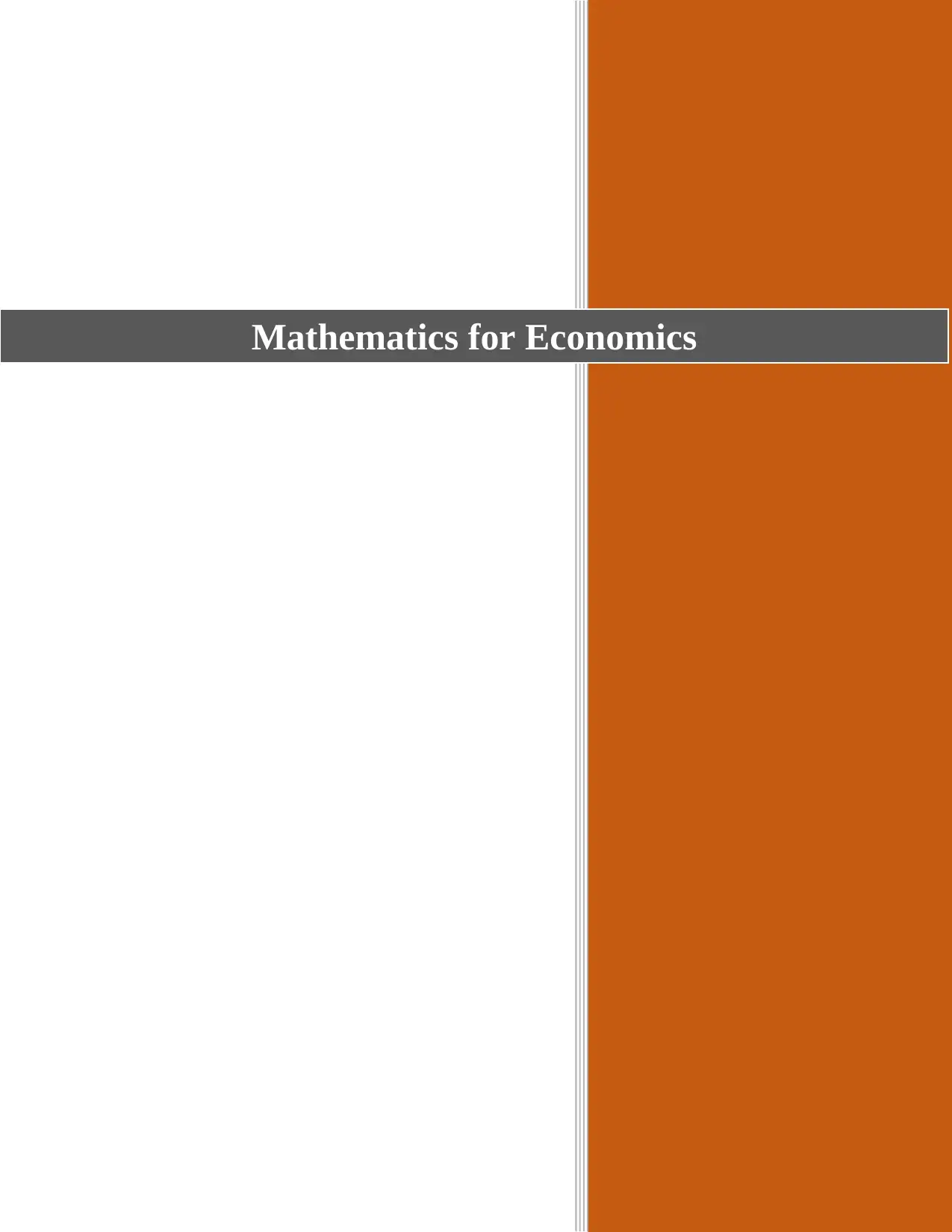
Mathematics for Economics
Paraphrase This Document
Need a fresh take? Get an instant paraphrase of this document with our AI Paraphraser
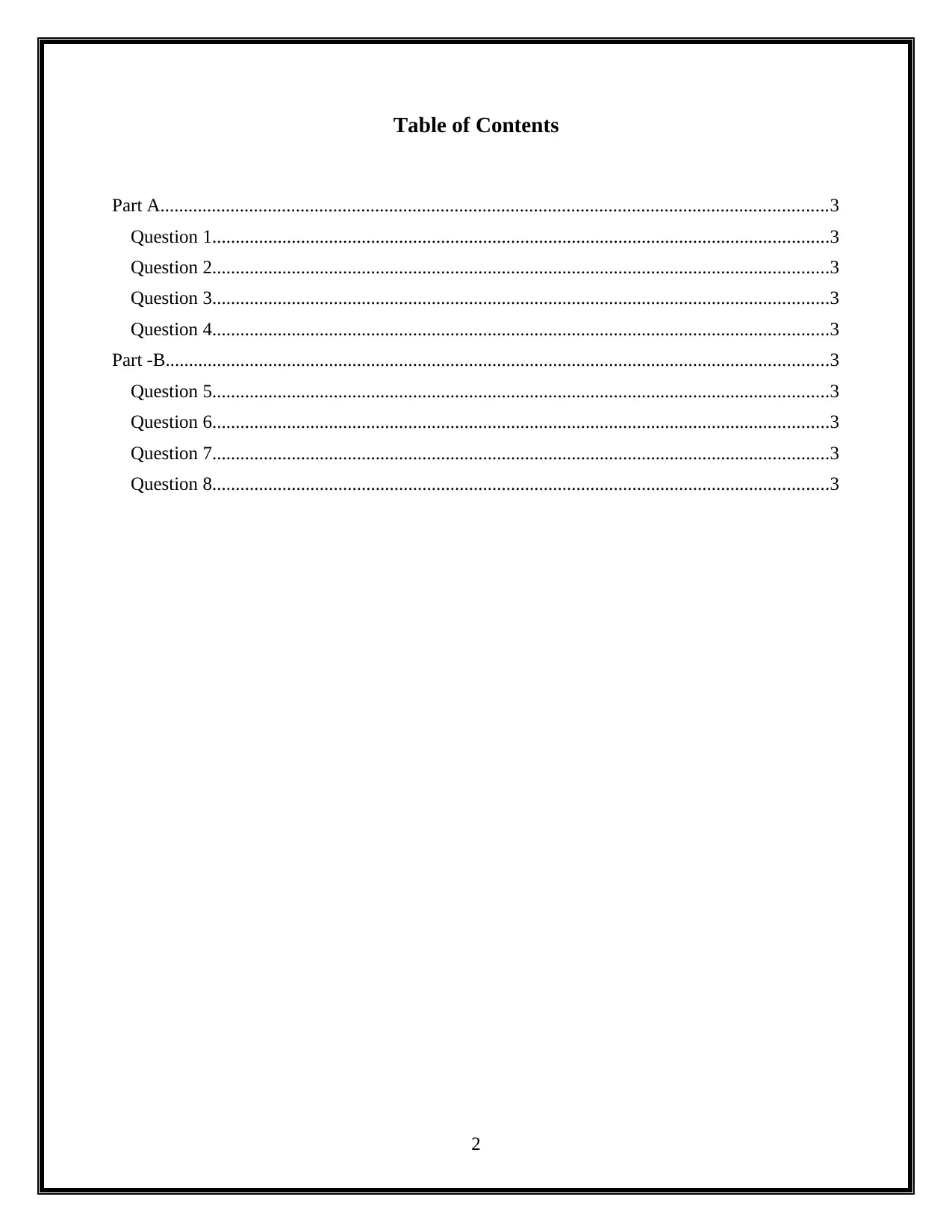
Table of Contents
Part A...............................................................................................................................................3
Question 1....................................................................................................................................3
Question 2....................................................................................................................................3
Question 3....................................................................................................................................3
Question 4....................................................................................................................................3
Part -B..............................................................................................................................................3
Question 5....................................................................................................................................3
Question 6....................................................................................................................................3
Question 7....................................................................................................................................3
Question 8....................................................................................................................................3
2
Part A...............................................................................................................................................3
Question 1....................................................................................................................................3
Question 2....................................................................................................................................3
Question 3....................................................................................................................................3
Question 4....................................................................................................................................3
Part -B..............................................................................................................................................3
Question 5....................................................................................................................................3
Question 6....................................................................................................................................3
Question 7....................................................................................................................................3
Question 8....................................................................................................................................3
2

Part A
Question 1
(a). Different the following function F (x) = -4x2+3x-1
F(x) = -4 x2+3x-1
F(2x)=2 F(x)
=-4 (2 x)2+3(2x)-1=2(-4 x2+3x-1)
=-16x2+6x-1=-8x2+3x-1
=-16 x2+8 x2+6x-6x-1+2
=-8 x2+1
=-( 8 x2−1 ¿
8 x2−1=0
8 x2=1
x2= 1
8
X= ± √ 1
8
The value of x is √ 1
8 or -
√ 1
8
F(2x)=f(x)
=-4 (2 x)2+3(2x)-1=-4 x2+3x-1
=-16x2+3x-1=4x2+3x-1
=-16 x2+4 x2+3x-3x-1+1
=- 12 x2+4x2=0
=-4x(3x-1)=0
-4x=0 3x-4=0
3
Question 1
(a). Different the following function F (x) = -4x2+3x-1
F(x) = -4 x2+3x-1
F(2x)=2 F(x)
=-4 (2 x)2+3(2x)-1=2(-4 x2+3x-1)
=-16x2+6x-1=-8x2+3x-1
=-16 x2+8 x2+6x-6x-1+2
=-8 x2+1
=-( 8 x2−1 ¿
8 x2−1=0
8 x2=1
x2= 1
8
X= ± √ 1
8
The value of x is √ 1
8 or -
√ 1
8
F(2x)=f(x)
=-4 (2 x)2+3(2x)-1=-4 x2+3x-1
=-16x2+3x-1=4x2+3x-1
=-16 x2+4 x2+3x-3x-1+1
=- 12 x2+4x2=0
=-4x(3x-1)=0
-4x=0 3x-4=0
3
⊘ This is a preview!⊘
Do you want full access?
Subscribe today to unlock all pages.

Trusted by 1+ million students worldwide
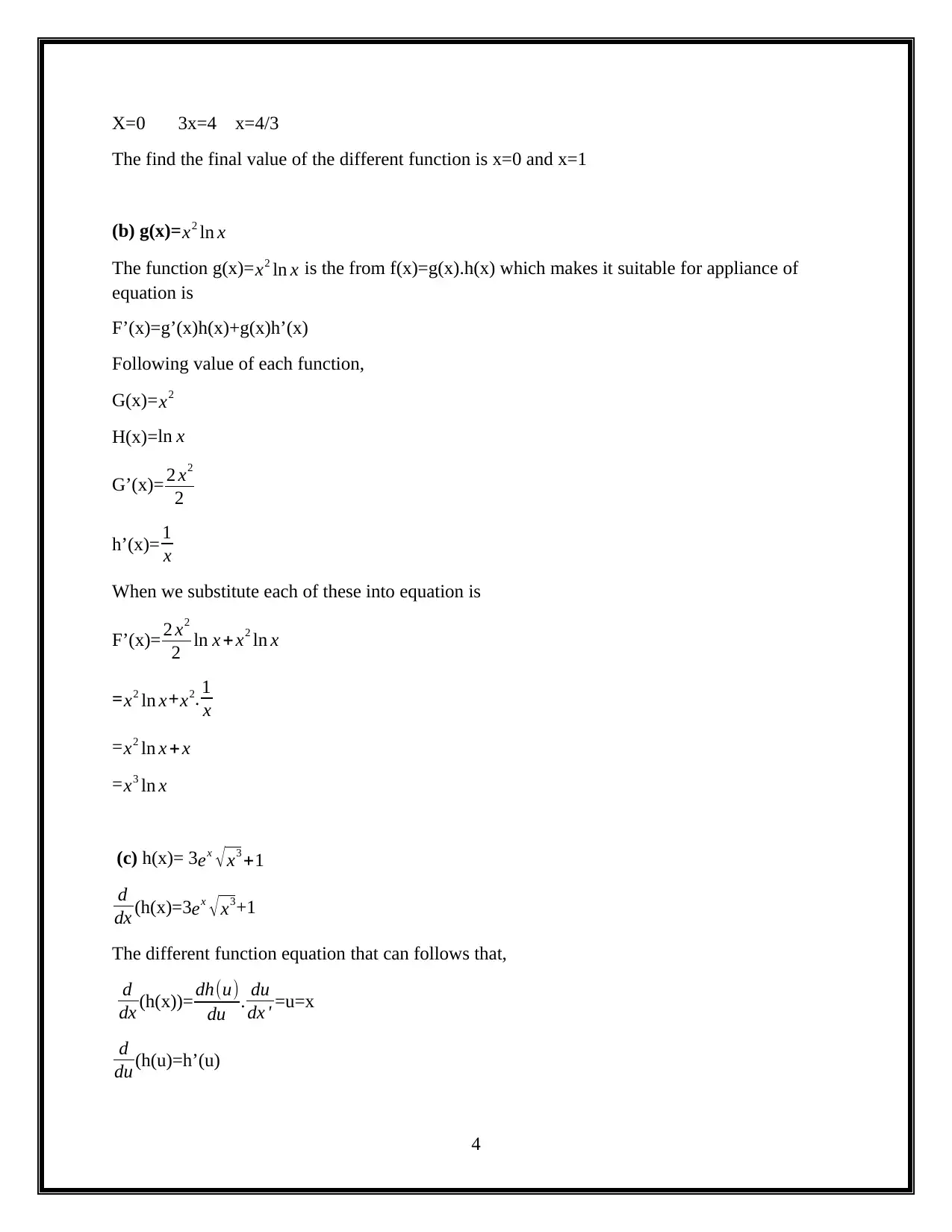
X=0 3x=4 x=4/3
The find the final value of the different function is x=0 and x=1
(b) g(x)=x2 ln x
The function g(x)= x2 ln x is the from f(x)=g(x).h(x) which makes it suitable for appliance of
equation is
F’(x)=g’(x)h(x)+g(x)h’(x)
Following value of each function,
G(x)=x2
H(x)= ln x
G’(x)= 2 x2
2
h’(x)= 1
x
When we substitute each of these into equation is
F’(x)= 2 x2
2 ln x + x2 ln x
= x2 ln x+ x2. 1
x
= x2 ln x + x
=x3 ln x
(c) h(x)= 3ex √ x3 +1
d
dx (h(x)=3ex √x3+1
The different function equation that can follows that,
d
dx (h(x))= dh(u)
du . du
dx ' =u=x
d
du (h(u)=h’(u)
4
The find the final value of the different function is x=0 and x=1
(b) g(x)=x2 ln x
The function g(x)= x2 ln x is the from f(x)=g(x).h(x) which makes it suitable for appliance of
equation is
F’(x)=g’(x)h(x)+g(x)h’(x)
Following value of each function,
G(x)=x2
H(x)= ln x
G’(x)= 2 x2
2
h’(x)= 1
x
When we substitute each of these into equation is
F’(x)= 2 x2
2 ln x + x2 ln x
= x2 ln x+ x2. 1
x
= x2 ln x + x
=x3 ln x
(c) h(x)= 3ex √ x3 +1
d
dx (h(x)=3ex √x3+1
The different function equation that can follows that,
d
dx (h(x))= dh(u)
du . du
dx ' =u=x
d
du (h(u)=h’(u)
4
Paraphrase This Document
Need a fresh take? Get an instant paraphrase of this document with our AI Paraphraser
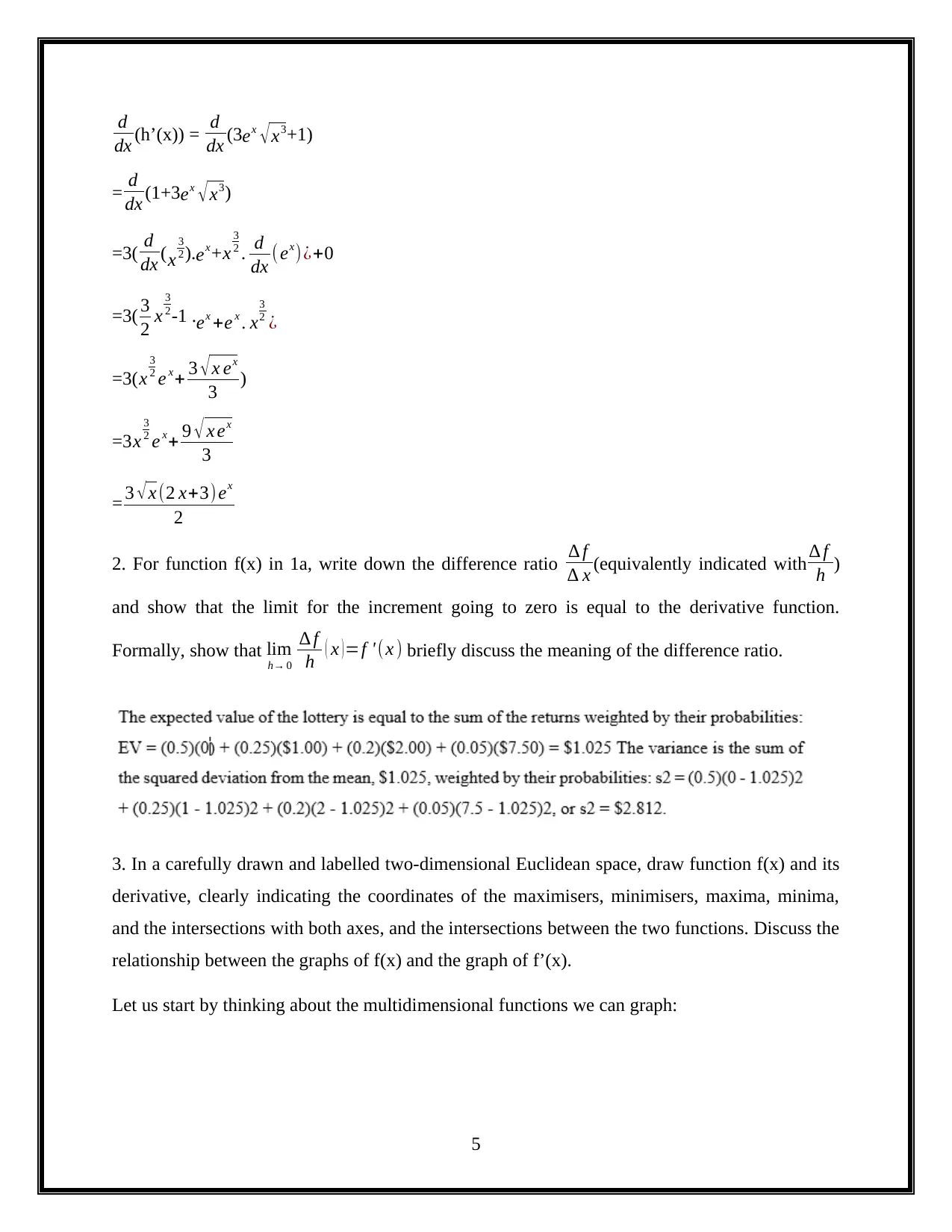
d
dx (h’(x)) = d
dx (3ex √x3+1)
= d
dx (1+3ex √x3)
=3( d
dx (x
3
2).ex+x
3
2 . d
dx (ex)¿+0
=3( 3
2 x
3
2-1 .ex +e x . x
3
2 ¿
=3(x
3
2 e x+ 3 √x ex
3 )
=3x
3
2 e x+ 9 √ x ex
3
= 3 √ x (2 x+3)ex
2
2. For function f(x) in 1a, write down the difference ratio ∆ f
∆ x (equivalently indicated with ∆ f
h )
and show that the limit for the increment going to zero is equal to the derivative function.
Formally, show that lim
h→ 0
∆ f
h ( x )=f ' (x ) briefly discuss the meaning of the difference ratio.
3. In a carefully drawn and labelled two-dimensional Euclidean space, draw function f(x) and its
derivative, clearly indicating the coordinates of the maximisers, minimisers, maxima, minima,
and the intersections with both axes, and the intersections between the two functions. Discuss the
relationship between the graphs of f(x) and the graph of f’(x).
Let us start by thinking about the multidimensional functions we can graph:
5
dx (h’(x)) = d
dx (3ex √x3+1)
= d
dx (1+3ex √x3)
=3( d
dx (x
3
2).ex+x
3
2 . d
dx (ex)¿+0
=3( 3
2 x
3
2-1 .ex +e x . x
3
2 ¿
=3(x
3
2 e x+ 3 √x ex
3 )
=3x
3
2 e x+ 9 √ x ex
3
= 3 √ x (2 x+3)ex
2
2. For function f(x) in 1a, write down the difference ratio ∆ f
∆ x (equivalently indicated with ∆ f
h )
and show that the limit for the increment going to zero is equal to the derivative function.
Formally, show that lim
h→ 0
∆ f
h ( x )=f ' (x ) briefly discuss the meaning of the difference ratio.
3. In a carefully drawn and labelled two-dimensional Euclidean space, draw function f(x) and its
derivative, clearly indicating the coordinates of the maximisers, minimisers, maxima, minima,
and the intersections with both axes, and the intersections between the two functions. Discuss the
relationship between the graphs of f(x) and the graph of f’(x).
Let us start by thinking about the multidimensional functions we can graph:
5
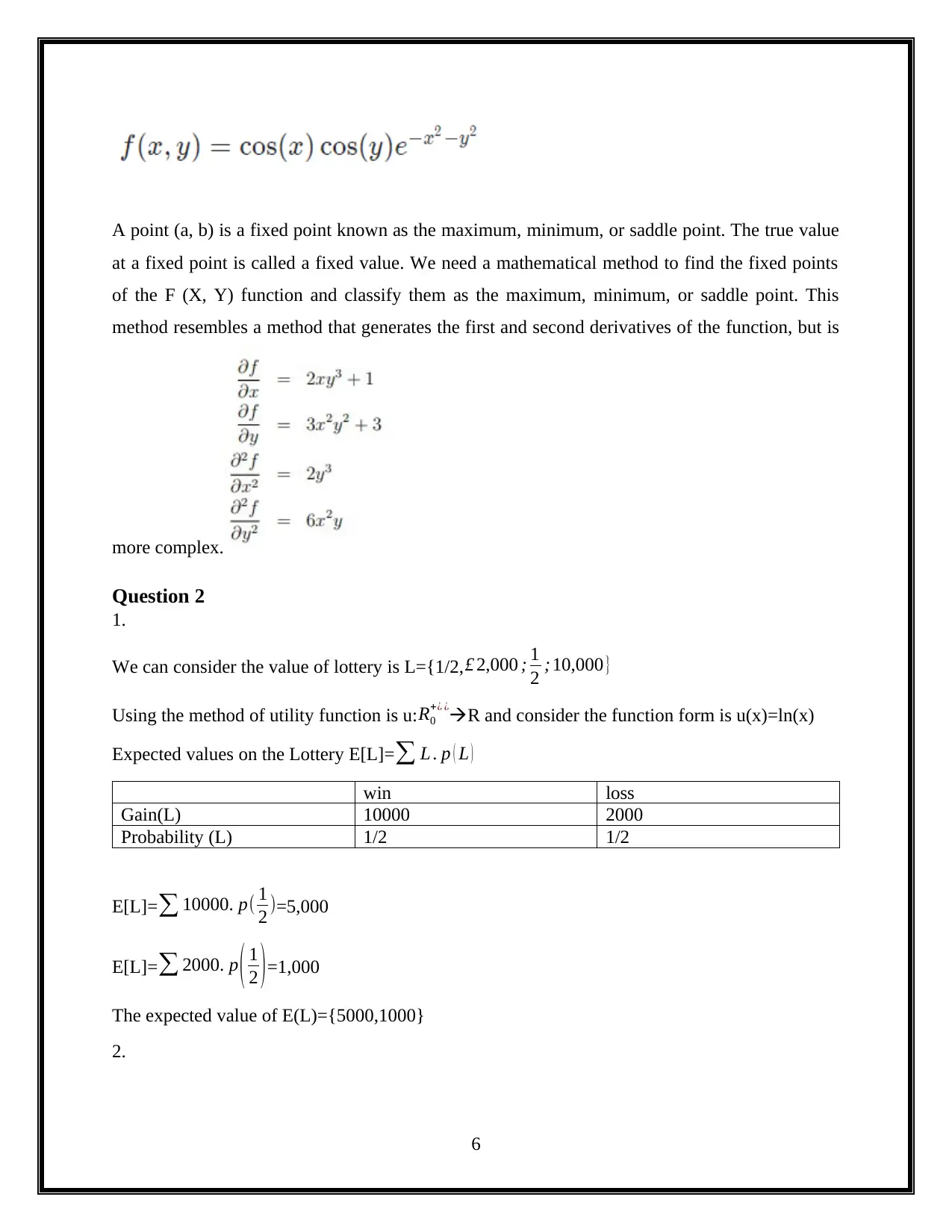
A point (a, b) is a fixed point known as the maximum, minimum, or saddle point. The true value
at a fixed point is called a fixed value. We need a mathematical method to find the fixed points
of the F (X, Y) function and classify them as the maximum, minimum, or saddle point. This
method resembles a method that generates the first and second derivatives of the function, but is
more complex.
Question 2
1.
We can consider the value of lottery is L={1/2,£ 2,000 ; 1
2 ;10,000}
Using the method of utility function is u: R0
+¿ ¿R and consider the function form is u(x)=ln(x)
Expected values on the Lottery E[L]=∑ L . p ( L )
win loss
Gain(L) 10000 2000
Probability (L) 1/2 1/2
E[L]=∑ 10000. p( 1
2 )=5,000
E[L]=∑ 2000. p ( 1
2 )=1,000
The expected value of E(L)={5000,1000}
2.
6
at a fixed point is called a fixed value. We need a mathematical method to find the fixed points
of the F (X, Y) function and classify them as the maximum, minimum, or saddle point. This
method resembles a method that generates the first and second derivatives of the function, but is
more complex.
Question 2
1.
We can consider the value of lottery is L={1/2,£ 2,000 ; 1
2 ;10,000}
Using the method of utility function is u: R0
+¿ ¿R and consider the function form is u(x)=ln(x)
Expected values on the Lottery E[L]=∑ L . p ( L )
win loss
Gain(L) 10000 2000
Probability (L) 1/2 1/2
E[L]=∑ 10000. p( 1
2 )=5,000
E[L]=∑ 2000. p ( 1
2 )=1,000
The expected value of E(L)={5000,1000}
2.
6
⊘ This is a preview!⊘
Do you want full access?
Subscribe today to unlock all pages.

Trusted by 1+ million students worldwide
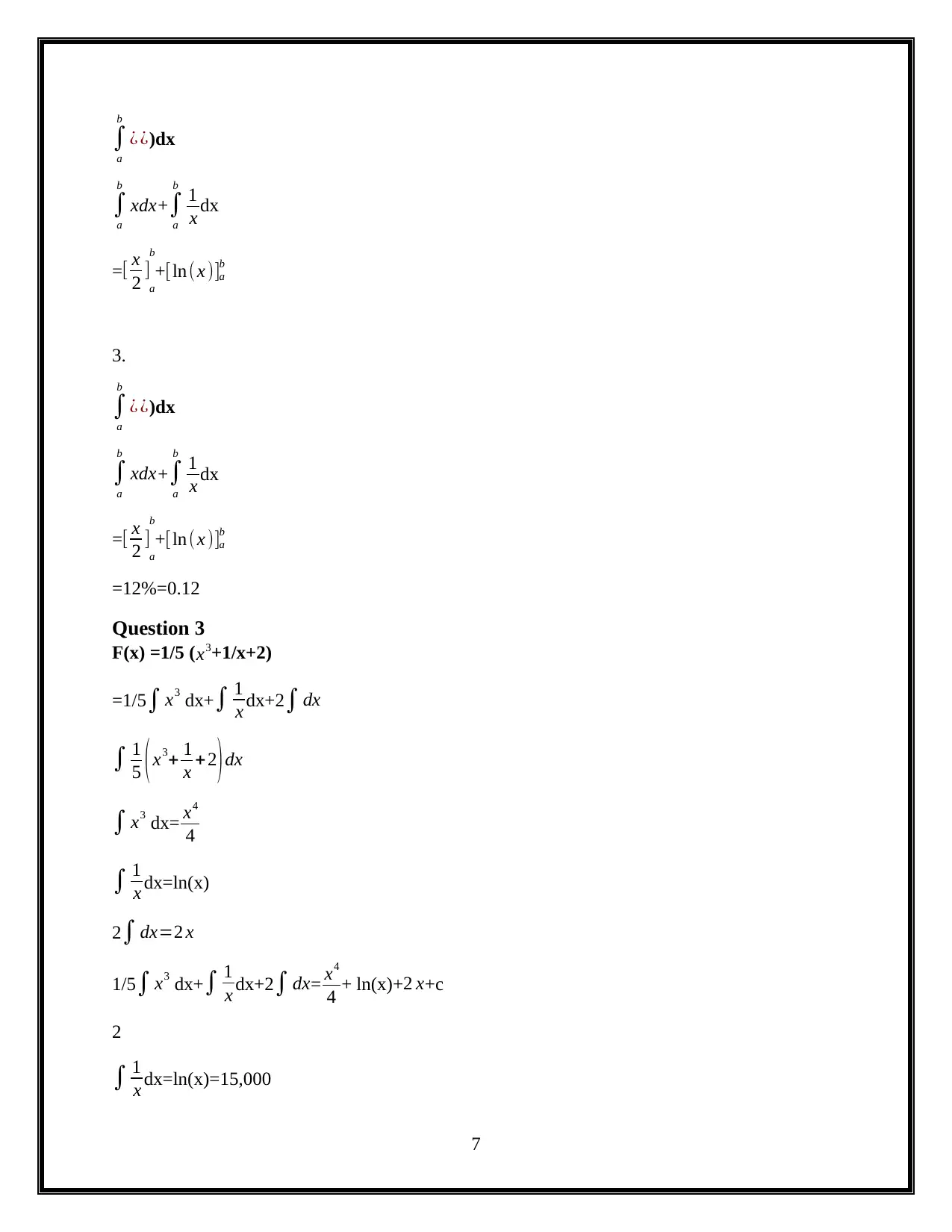
∫
a
b
¿ ¿)dx
∫
a
b
xdx+∫
a
b
1
x dx
=[ x
2 ]a
b
+[ln ( x )]a
b
3.
∫
a
b
¿ ¿)dx
∫
a
b
xdx+∫
a
b
1
x dx
=[ x
2 ]a
b
+[ln ( x )]a
b
=12%=0.12
Question 3
F(x) =1/5 (x3+1/x+2)
=1/5∫ x3 dx+∫ 1
x dx+2∫ dx
∫ 1
5 (x3+ 1
x + 2)dx
∫ x3 dx= x4
4
∫ 1
x dx=ln(x)
2∫ dx=2 x
1/5∫ x3 dx+∫ 1
x dx+2∫ dx= x4
4 + ln(x)+2 x+c
2
∫ 1
x dx=ln(x)=15,000
7
a
b
¿ ¿)dx
∫
a
b
xdx+∫
a
b
1
x dx
=[ x
2 ]a
b
+[ln ( x )]a
b
3.
∫
a
b
¿ ¿)dx
∫
a
b
xdx+∫
a
b
1
x dx
=[ x
2 ]a
b
+[ln ( x )]a
b
=12%=0.12
Question 3
F(x) =1/5 (x3+1/x+2)
=1/5∫ x3 dx+∫ 1
x dx+2∫ dx
∫ 1
5 (x3+ 1
x + 2)dx
∫ x3 dx= x4
4
∫ 1
x dx=ln(x)
2∫ dx=2 x
1/5∫ x3 dx+∫ 1
x dx+2∫ dx= x4
4 + ln(x)+2 x+c
2
∫ 1
x dx=ln(x)=15,000
7
Paraphrase This Document
Need a fresh take? Get an instant paraphrase of this document with our AI Paraphraser
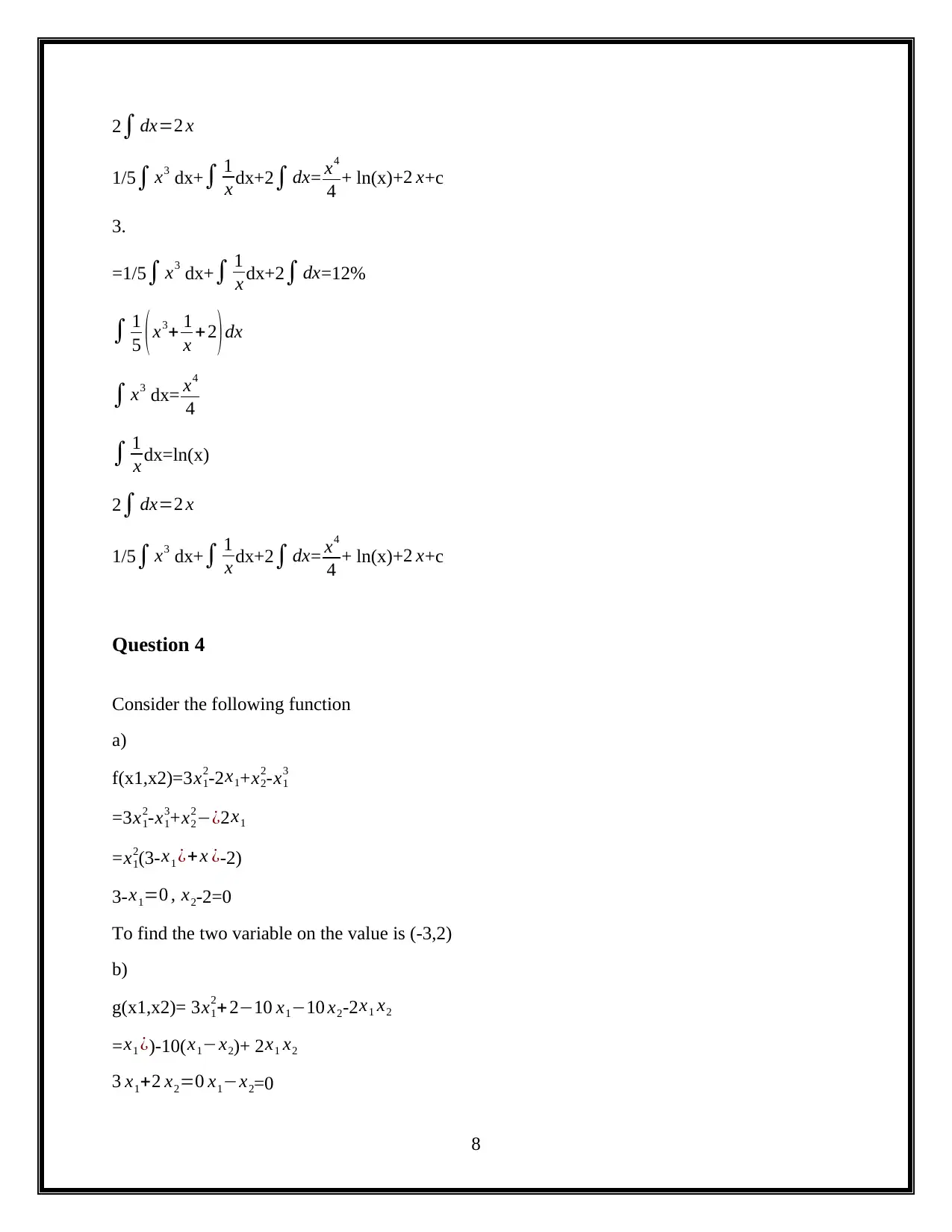
2∫ dx=2 x
1/5∫ x3 dx+∫ 1
x dx+2∫ dx= x4
4 + ln(x)+2 x+c
3.
=1/5∫ x3 dx+∫ 1
x dx+2∫ dx=12%
∫ 1
5 (x3+ 1
x + 2)dx
∫ x3 dx= x4
4
∫ 1
x dx=ln(x)
2∫ dx=2 x
1/5∫ x3 dx+∫ 1
x dx+2∫ dx= x4
4 + ln(x)+2 x+c
Question 4
Consider the following function
a)
f(x1,x2)=3x1
2-2 x1+x2
2-x1
3
=3 x1
2- x1
3+ x2
2−¿2x1
=x1
2(3- x1 ¿+x ¿-2)
3- x1=0 , x2-2=0
To find the two variable on the value is (-3,2)
b)
g(x1,x2)= 3 x1
2+2−10 x1−10 x2-2 x1 x2
= x1 ¿)-10( x1−x2)+ 2 x1 x2
3 x1+2 x2=0 x1−x2=0
8
1/5∫ x3 dx+∫ 1
x dx+2∫ dx= x4
4 + ln(x)+2 x+c
3.
=1/5∫ x3 dx+∫ 1
x dx+2∫ dx=12%
∫ 1
5 (x3+ 1
x + 2)dx
∫ x3 dx= x4
4
∫ 1
x dx=ln(x)
2∫ dx=2 x
1/5∫ x3 dx+∫ 1
x dx+2∫ dx= x4
4 + ln(x)+2 x+c
Question 4
Consider the following function
a)
f(x1,x2)=3x1
2-2 x1+x2
2-x1
3
=3 x1
2- x1
3+ x2
2−¿2x1
=x1
2(3- x1 ¿+x ¿-2)
3- x1=0 , x2-2=0
To find the two variable on the value is (-3,2)
b)
g(x1,x2)= 3 x1
2+2−10 x1−10 x2-2 x1 x2
= x1 ¿)-10( x1−x2)+ 2 x1 x2
3 x1+2 x2=0 x1−x2=0
8
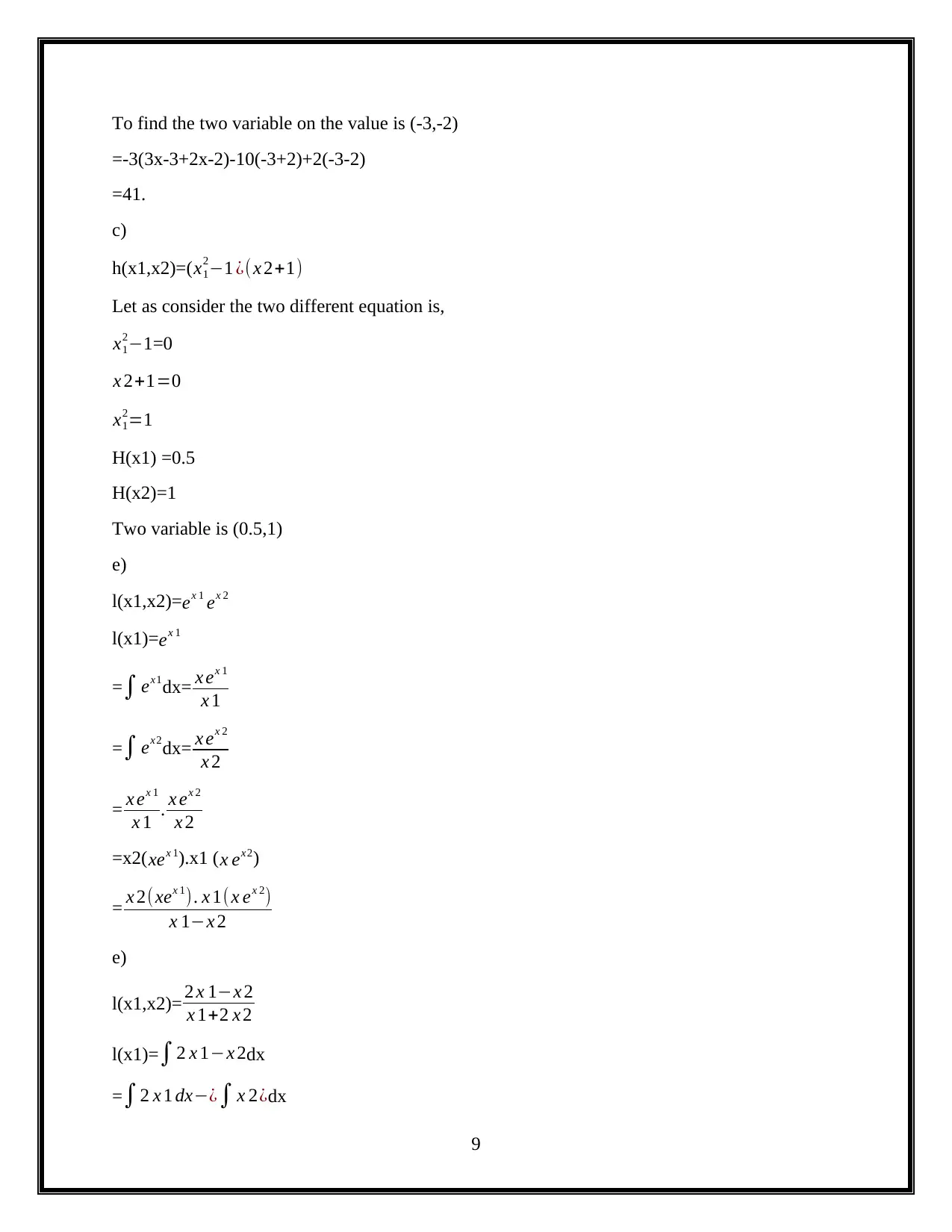
To find the two variable on the value is (-3,-2)
=-3(3x-3+2x-2)-10(-3+2)+2(-3-2)
=41.
c)
h(x1,x2)=(x1
2−1 ¿( x 2+1)
Let as consider the two different equation is,
x1
2−1=0
x 2+1=0
x1
2=1
H(x1) =0.5
H(x2)=1
Two variable is (0.5,1)
e)
l(x1,x2)=ex 1 ex 2
l(x1)=ex 1
=∫ ex1dx= x ex 1
x 1
=∫ ex2dx= x ex 2
x 2
= x ex 1
x 1 . x ex 2
x 2
=x2( xex 1).x1 ( x ex2)
= x 2(xex 1) . x 1( x ex 2)
x 1−x 2
e)
l(x1,x2)= 2 x 1−x 2
x 1+2 x 2
l(x1)=∫2 x 1−x 2dx
=∫2 x 1 dx−¿∫ x 2¿dx
9
=-3(3x-3+2x-2)-10(-3+2)+2(-3-2)
=41.
c)
h(x1,x2)=(x1
2−1 ¿( x 2+1)
Let as consider the two different equation is,
x1
2−1=0
x 2+1=0
x1
2=1
H(x1) =0.5
H(x2)=1
Two variable is (0.5,1)
e)
l(x1,x2)=ex 1 ex 2
l(x1)=ex 1
=∫ ex1dx= x ex 1
x 1
=∫ ex2dx= x ex 2
x 2
= x ex 1
x 1 . x ex 2
x 2
=x2( xex 1).x1 ( x ex2)
= x 2(xex 1) . x 1( x ex 2)
x 1−x 2
e)
l(x1,x2)= 2 x 1−x 2
x 1+2 x 2
l(x1)=∫2 x 1−x 2dx
=∫2 x 1 dx−¿∫ x 2¿dx
9
⊘ This is a preview!⊘
Do you want full access?
Subscribe today to unlock all pages.

Trusted by 1+ million students worldwide
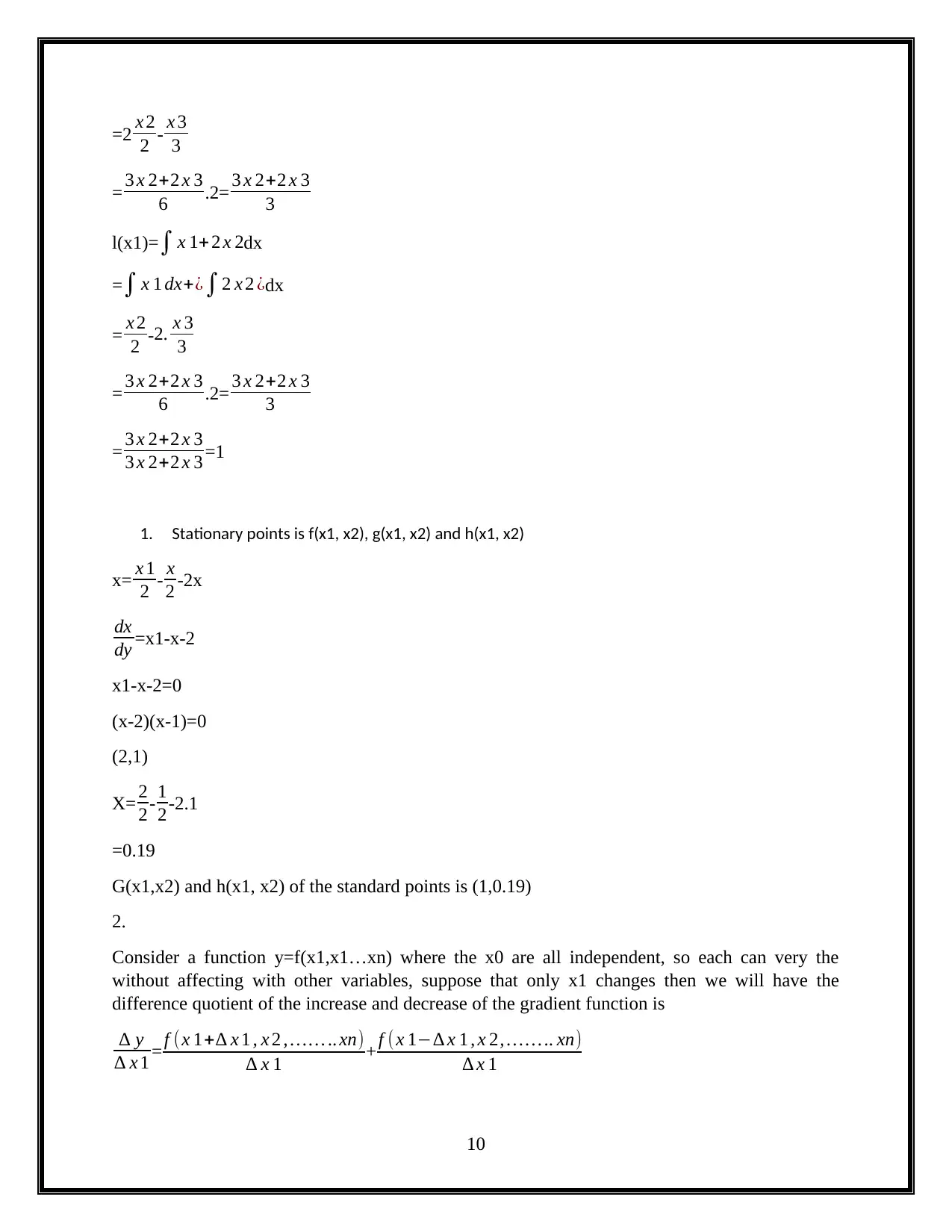
=2 x 2
2 - x 3
3
= 3 x 2+2 x 3
6 .2= 3 x 2+2 x 3
3
l(x1)=∫ x 1+ 2 x 2dx
=∫ x 1 dx+¿∫2 x 2 ¿dx
= x 2
2 -2. x 3
3
= 3 x 2+2 x 3
6 .2= 3 x 2+2 x 3
3
= 3 x 2+2 x 3
3 x 2+2 x 3 =1
1. Stationary points is f(x1, x2), g(x1, x2) and h(x1, x2)
x= x 1
2 - x
2 -2x
dx
dy =x1-x-2
x1-x-2=0
(x-2)(x-1)=0
(2,1)
X= 2
2- 1
2-2.1
=0.19
G(x1,x2) and h(x1, x2) of the standard points is (1,0.19)
2.
Consider a function y=f(x1,x1…xn) where the x0 are all independent, so each can very the
without affecting with other variables, suppose that only x1 changes then we will have the
difference quotient of the increase and decrease of the gradient function is
∆ y
∆ x 1 = f (x 1+∆ x 1 , x 2 , … … .. xn)
∆ x 1 + f ( x 1−∆ x 1 , x 2, … … .. xn)
∆ x 1
10
2 - x 3
3
= 3 x 2+2 x 3
6 .2= 3 x 2+2 x 3
3
l(x1)=∫ x 1+ 2 x 2dx
=∫ x 1 dx+¿∫2 x 2 ¿dx
= x 2
2 -2. x 3
3
= 3 x 2+2 x 3
6 .2= 3 x 2+2 x 3
3
= 3 x 2+2 x 3
3 x 2+2 x 3 =1
1. Stationary points is f(x1, x2), g(x1, x2) and h(x1, x2)
x= x 1
2 - x
2 -2x
dx
dy =x1-x-2
x1-x-2=0
(x-2)(x-1)=0
(2,1)
X= 2
2- 1
2-2.1
=0.19
G(x1,x2) and h(x1, x2) of the standard points is (1,0.19)
2.
Consider a function y=f(x1,x1…xn) where the x0 are all independent, so each can very the
without affecting with other variables, suppose that only x1 changes then we will have the
difference quotient of the increase and decrease of the gradient function is
∆ y
∆ x 1 = f (x 1+∆ x 1 , x 2 , … … .. xn)
∆ x 1 + f ( x 1−∆ x 1 , x 2, … … .. xn)
∆ x 1
10
Paraphrase This Document
Need a fresh take? Get an instant paraphrase of this document with our AI Paraphraser
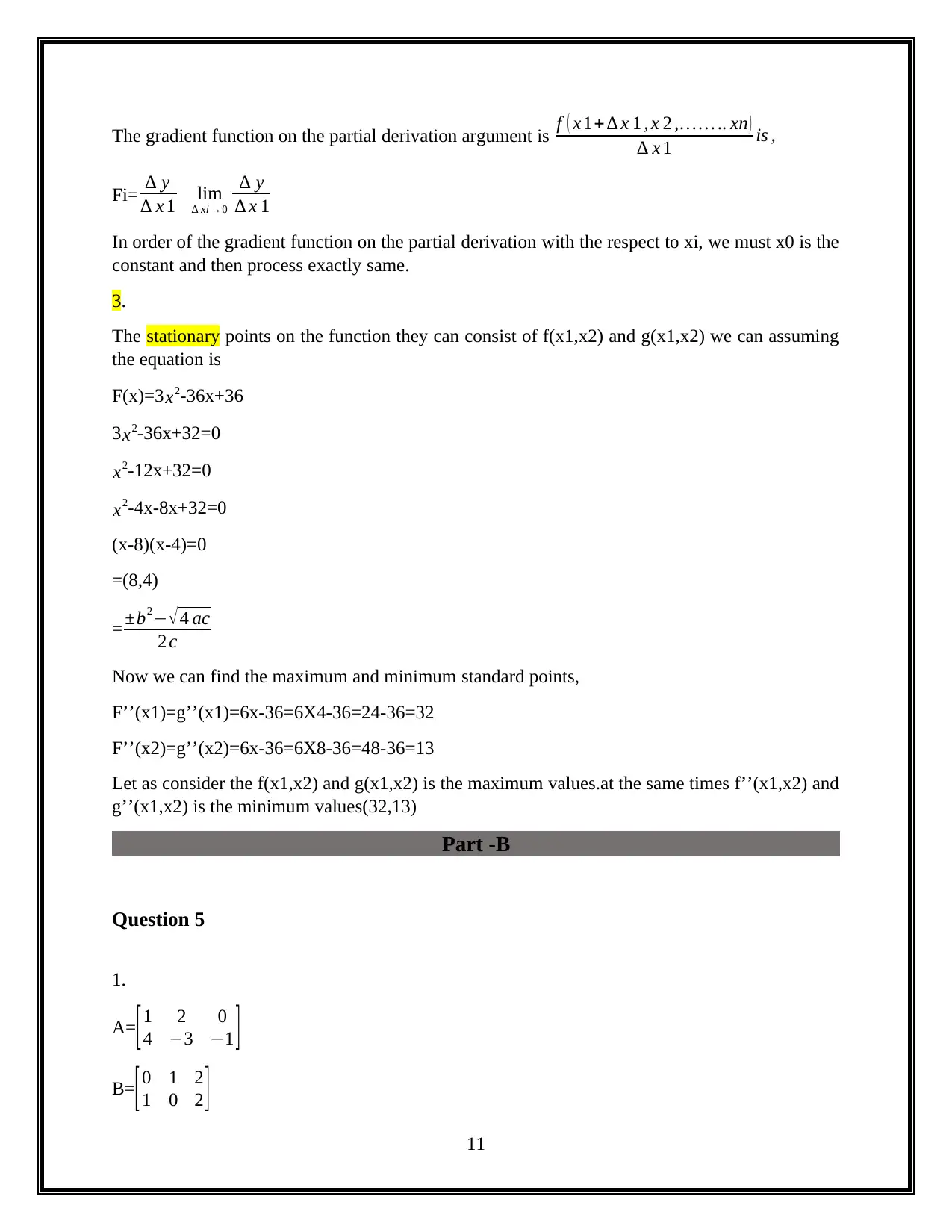
The gradient function on the partial derivation argument is f ( x 1+∆ x 1 , x 2 ,… … .. xn )
∆ x 1 is ,
Fi= ∆ y
∆ x 1 lim
∆ xi →0
∆ y
∆ x 1
In order of the gradient function on the partial derivation with the respect to xi, we must x0 is the
constant and then process exactly same.
3.
The stationary points on the function they can consist of f(x1,x2) and g(x1,x2) we can assuming
the equation is
F(x)=3 x2-36x+36
3x2-36x+32=0
x2-12x+32=0
x2-4x-8x+32=0
(x-8)(x-4)=0
=(8,4)
= ±b2− √ 4 ac
2 c
Now we can find the maximum and minimum standard points,
F’’(x1)=g’’(x1)=6x-36=6X4-36=24-36=32
F’’(x2)=g’’(x2)=6x-36=6X8-36=48-36=13
Let as consider the f(x1,x2) and g(x1,x2) is the maximum values.at the same times f’’(x1,x2) and
g’’(x1,x2) is the minimum values(32,13)
Part -B
Question 5
1.
A= [1 2 0
4 −3 −1 ]
B= [ 0 1 2
1 0 2 ]
11
∆ x 1 is ,
Fi= ∆ y
∆ x 1 lim
∆ xi →0
∆ y
∆ x 1
In order of the gradient function on the partial derivation with the respect to xi, we must x0 is the
constant and then process exactly same.
3.
The stationary points on the function they can consist of f(x1,x2) and g(x1,x2) we can assuming
the equation is
F(x)=3 x2-36x+36
3x2-36x+32=0
x2-12x+32=0
x2-4x-8x+32=0
(x-8)(x-4)=0
=(8,4)
= ±b2− √ 4 ac
2 c
Now we can find the maximum and minimum standard points,
F’’(x1)=g’’(x1)=6x-36=6X4-36=24-36=32
F’’(x2)=g’’(x2)=6x-36=6X8-36=48-36=13
Let as consider the f(x1,x2) and g(x1,x2) is the maximum values.at the same times f’’(x1,x2) and
g’’(x1,x2) is the minimum values(32,13)
Part -B
Question 5
1.
A= [1 2 0
4 −3 −1 ]
B= [ 0 1 2
1 0 2 ]
11
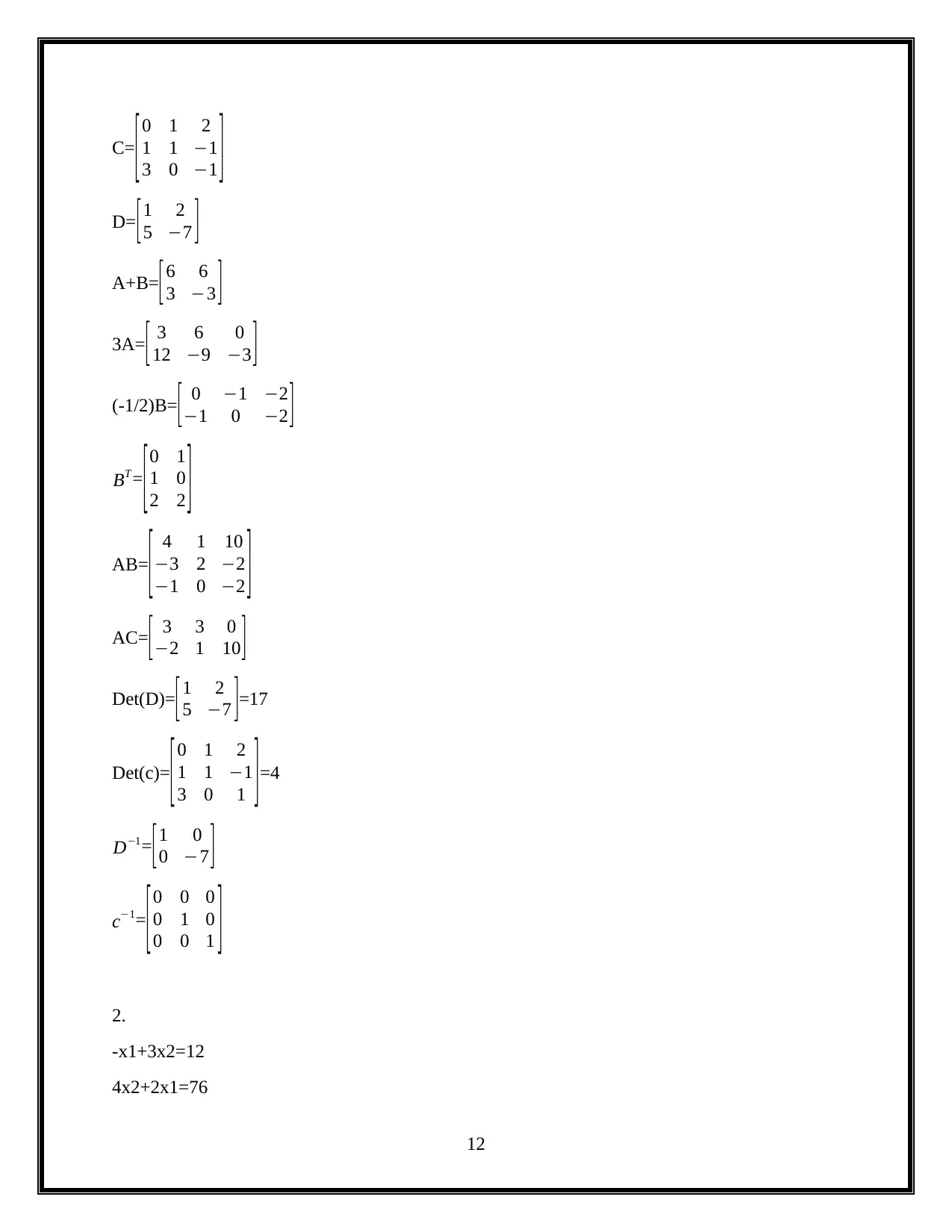
C= [0 1 2
1 1 −1
3 0 −1 ]
D= [1 2
5 −7 ]
A+B=[ 6 6
3 −3 ]
3A= [ 3 6 0
12 −9 −3 ]
(-1/2)B=[ 0 −1 −2
−1 0 −2 ]
BT =
[0 1
1 0
2 2 ]
AB= [ 4 1 10
−3 2 −2
−1 0 −2 ]
AC= [ 3 3 0
−2 1 10 ]
Det(D)= [ 1 2
5 −7 ]=17
Det(c)=
[0 1 2
1 1 −1
3 0 1 ]=4
D−1=[ 1 0
0 −7 ]
c−1=
[0 0 0
0 1 0
0 0 1 ]
2.
-x1+3x2=12
4x2+2x1=76
12
1 1 −1
3 0 −1 ]
D= [1 2
5 −7 ]
A+B=[ 6 6
3 −3 ]
3A= [ 3 6 0
12 −9 −3 ]
(-1/2)B=[ 0 −1 −2
−1 0 −2 ]
BT =
[0 1
1 0
2 2 ]
AB= [ 4 1 10
−3 2 −2
−1 0 −2 ]
AC= [ 3 3 0
−2 1 10 ]
Det(D)= [ 1 2
5 −7 ]=17
Det(c)=
[0 1 2
1 1 −1
3 0 1 ]=4
D−1=[ 1 0
0 −7 ]
c−1=
[0 0 0
0 1 0
0 0 1 ]
2.
-x1+3x2=12
4x2+2x1=76
12
⊘ This is a preview!⊘
Do you want full access?
Subscribe today to unlock all pages.

Trusted by 1+ million students worldwide
1 out of 24
Related Documents
Your All-in-One AI-Powered Toolkit for Academic Success.
+13062052269
info@desklib.com
Available 24*7 on WhatsApp / Email
![[object Object]](/_next/static/media/star-bottom.7253800d.svg)
Unlock your academic potential
Copyright © 2020–2025 A2Z Services. All Rights Reserved. Developed and managed by ZUCOL.





